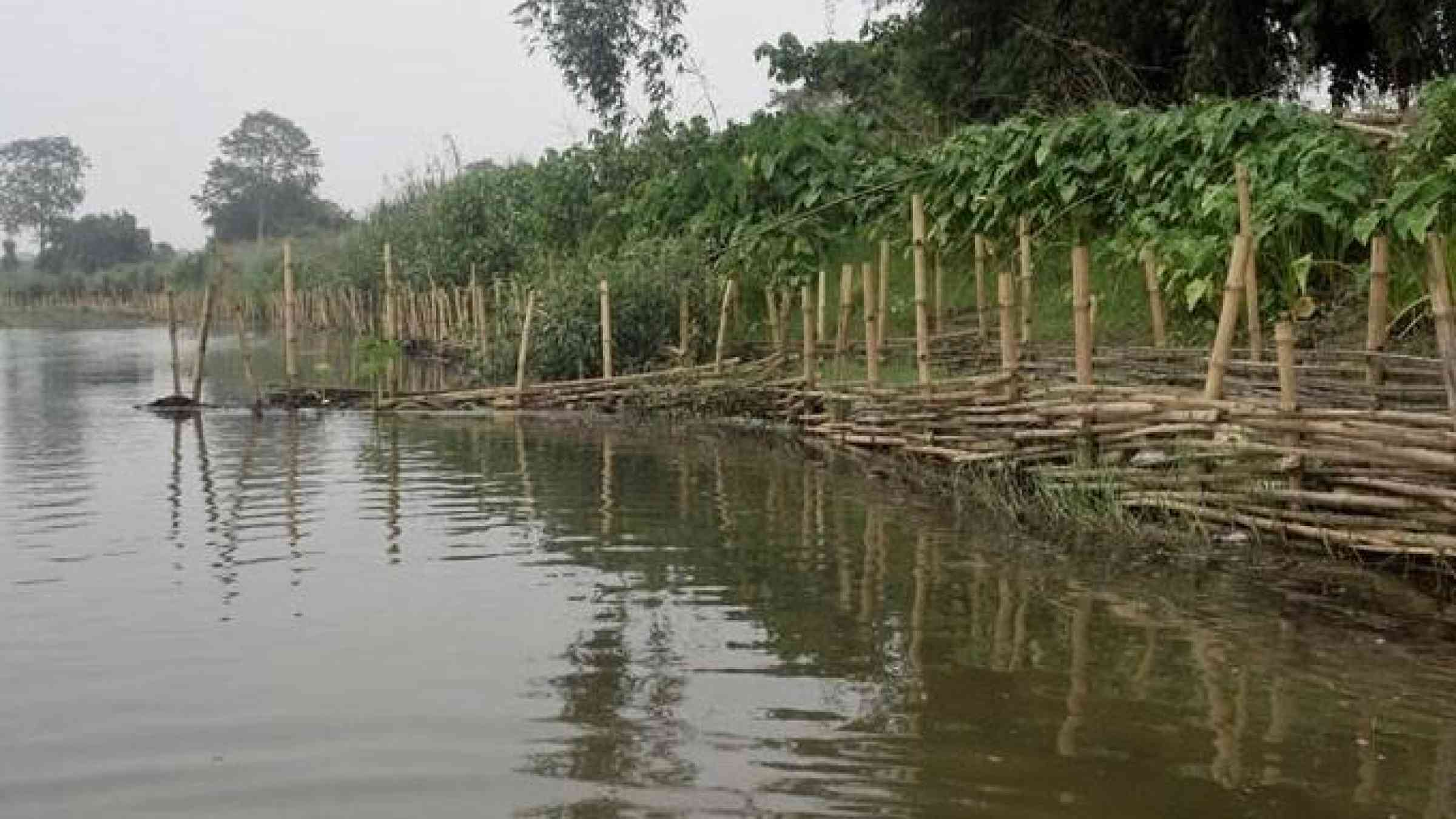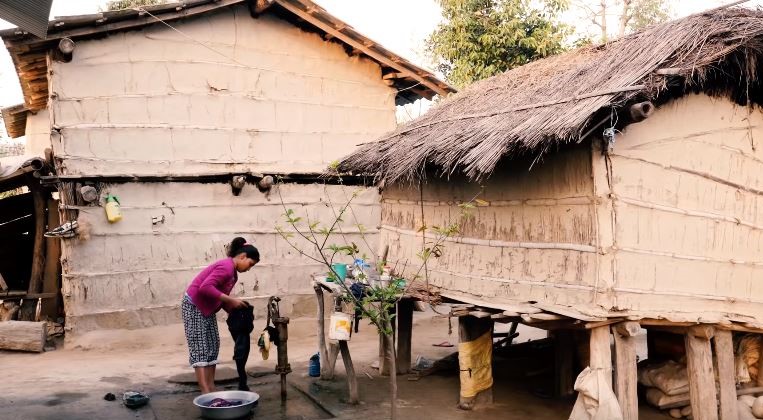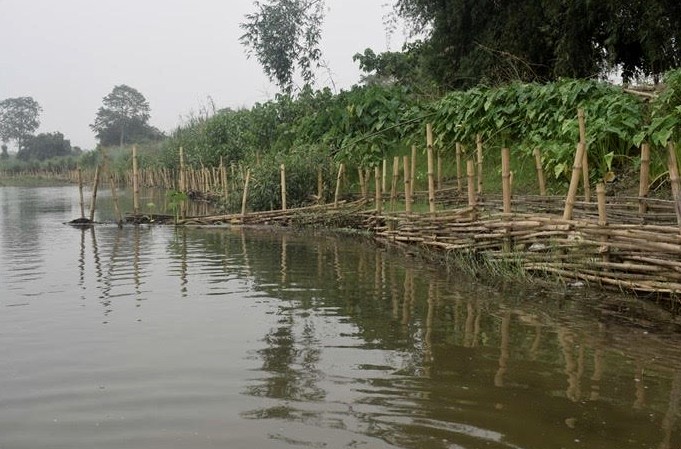Please help us improve PreventionWeb by taking this brief survey. Your input will allow us to better serve the needs of the DRR community.
Communities on the frontlines of flood management in Nepal

Organic dam/Rabin Sharma
In Nepal, 80% of the country’s population is exposed to natural hazards, among which flood is a major one. The Terai region of Nepal is particularly affected by historical disaster loss. Historical loss data illustrates the increase in the scale, intensity, and duration of floods. Between 1970 and 2019, 4,058 deaths, 1,028 disappearances, 692 injuries, 178,833 displacement, and 451,6687 affected families were reported. The damages amounted to more than 23 billion, and are equivalent to 2.6 percent of Nepal’s GDP per annum (Nepal Disaster Report, GoN, 2019).
When disasters strike, people in affected communities are the first responders. Translating their local knowledge and perspectives into preparatory actions can help create solutions that are cost-effective, sustainable, and generally well accepted by community members. For instance, communities build two-story houses using easily available local resources such as mud, woods, bamboos, reeds, and bushes. While those houses are primarily used for storing agricultural products, they also operate as emergency shelters. They are easy to access by everyone and especially children and people living with a disability. In other communities, locals build environmentally friendly “organic dams” to control riverbanks erosion, which improves the resistance of embankments.

Image: Two-story building/Rabin Sharma

Image: Organic dam/Rabin Sharma
This set of creative strategies allows communities to live in flood-prone areas, accepting the paradigm shift from “fighting with floods to living with floods as a novel way of life”.
Yet, efforts to increase community involvement in mainstream disaster management activities remain insufficient. Community participation is too limited before and after projects. When programs have no exit strategies, projects are not sustainable in the long term and issues arise around ownership and accountability.
Way forward
Proper planning is critical. Community-based flood management must be part of local and national DRR strategies. Local governments have to take immediate action to identify risks drawing on their local knowledge. Plans must provide a fine balance between physical infrastructure and improved forecasting and warning systems, among other strategies.
Risk reduction initiatives should also account for the diversity of local populations. Community-based early warning system (CB-EWS) exist in some places in Nepal, yet messages are often disseminated in only one language, even though people can speak different languages. Consequently, some people misunderstand the messages or just ignore them.
CB-EWS should also draw on traditional knowledge. For example, if clouds appear in the southern corner of the sky, the locals understand that there will be no rain, whereas when clouds appear in the northwest corner of the sky, they see it as a sign of potential precipitation.
To be better understood by the communities, early warning systems should follow an impact-based forecasting approach. Messages should describe the potential impact of weather events so people can take appropriate action.
DRR initiatives should also better leverage advances in technology. New technologies offer promising avenues to localize risk assessments and develop community-based early warning systems. For instance, the Building Information Platform Against Disaster (BIPAD) will strengthen local governments' capacity to identify areas and vulnerable communities and groups exposed to natural hazards. Drawing on information from BIPAD, decision-making processes can be more effective.
Evidently, successful localization will require comprehensive technical guidelines and building the capacity of local governments. The Disaster Risk Reduction – Youth Leaders Fellowship (DRR-YLF) will help develop the capacity at the local level to localize risk information.
Finally, any proposed solution must be designed with the involvement of those most affected. As the custodians of rich local knowledge, they can provide valuable insights to build the resilience of their communities.
Rabin Sharma is working as a Disaster Risk Reduction (DRR) researcher since 2017. He completed his Master’s degree in Crisis, Emergency, and Disaster Management in 2019 from the Institute of Crisis Management Studies (ICMS), an affiliation of Tribhuvan University, Nepal. His professional experiences include working with national and international organizations. His core working interest areas are community-based disaster risk management (CB-DRRM), community-based flood risk management (CB-FRM), vulnerability assessment, crisis management, disaster risk reduction, capacity building of the local government against the disasters, developing local disaster management plans, emergency preparedness and crisis management plan (EP-CMP). Currently, he is serving as a Disaster Risk Reduction- Young Leader Fellow (DRR-YLF) with the aim to build technical capacities of local governments for further localization of the National Disaster Information System (DIMS), locally known as Building Information Platform Against Disaster (BIPAD). Rabin is also an active volunteer member at U-Inspire Nepal.
Explore further
Please note: Content is displayed as last posted by a PreventionWeb community member or editor. The views expressed therein are not necessarily those of UNDRR, PreventionWeb, or its sponsors. See our terms of use
Is this page useful?
Yes No Report an issue on this pageThank you. If you have 2 minutes, we would benefit from additional feedback (link opens in a new window).